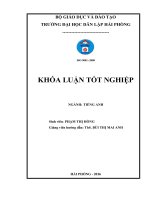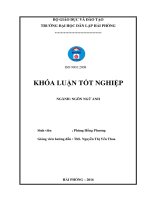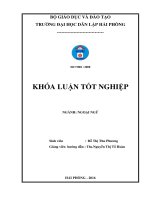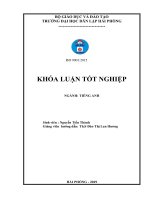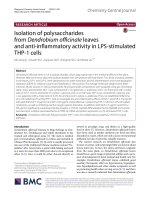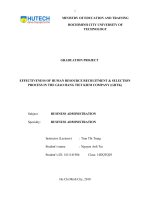Fermentation of ginseng extracts by probiotic bacteria and their antimicrobial and anti oxidant activity (khóa luận tốt nghiệp)
Bạn đang xem bản rút gọn của tài liệu. Xem và tải ngay bản đầy đủ của tài liệu tại đây (800.21 KB, 41 trang )
VIETNAM NATIONAL UNIVERSITY OF AGRICULTURE
FACULTY OF BIOTECHNOLOGY
GRADUATION THESIS
TITLE:
FERMENTATION OF GINSENG
EXTRACTS BY PROBIOTIC BACTERIA AND THEIR
ANTIMICROBIAL AND ANTI-OXIDANT ACTIVITY
HANOI, 2021
VIETNAM NATIONAL UNIVERSITY OF AGRICULTURE
FACULTY OF BIOTECHNOLOGY
GRADUATION THESIS
TITLE:
FERMENTATION OF GINSENG
EXTRACTS BY PROBIOTIC BACTERIA AND THEIR
ANTIMICROBIAL AND ANTI-OXIDANT ACTIVITY
Student
Supervisor
:
:
Student code
Class
Location
:
:
:
Le Minh Vy
Dr. Bui Thi Thu Huong
Dr. Le Thi Hoang Yen
Dr. Vu Duy Nhan
610691
K61CNSHE
Institute of Microbiology
and Biotechnology, VNUA
HANOI, 2021
DECLARATION
I hereby declare that this paper was my own work. All results and data in this
title were absolutely honest and have not been submitted before to any institution for
assessment purposes. All sources used in this paper were cited in references.
Student
Le Minh Vy
i
ACKNOWLEDGEMENTS
I would like to express my respect and deep gratitude to Dr. Bui Thi Thu
Huong, Dr. Le Thi Hoang Yen and Dr. Vu Duy Nhan, for giving me the opportunity
to carry out this work, and their huge efforts, enthusiasm, and support throughout the
duration of the undergraduate thesis.
I would like to express sincere gratitude to all the staff of the Institute of
Microbiology and Biotechnology who were enthusiastic to help me through the
project.
Finally, I would like to thank my family, those with us and those sadly
departed. You provided fantastic support and inspiration throughout the duration of
this undergraduate thesis, and without you all, this would never have been possible.
Student
Le Minh Vy
ii
CONTENTS
DECLARATION .............................................................................................................. i
ACKNOWLEDGEMENTS ............................................................................................ ii
CONTENTS ...................................................................................................................iii
LIST OF TABLE ............................................................................................................. v
LIST OF FIGURE .......................................................................................................... vi
PART I: INTRODUCTION ............................................................................................ 1
1.1.
Preface .................................................................................................................. 1
1.2.
Objectives and requirements ................................................................................ 1
PART II: OVERVIEW .................................................................................................... 2
2.1.
Introduction of ginseng......................................................................................... 2
2.1.1. Ginseng ................................................................................................................. 2
2.1.2. Ingredients and uses ............................................................................................. 4
2.2.
Overview of fermented ginseng ........................................................................... 6
2.2.1. Methods of ginsenoside metabolism .................................................................... 6
2.2.2. Mechanism of the fermentation method ............................................................... 8
2.3.
Enzyme β-glucosidase .......................................................................................... 9
PART III: MATERIALS, CONTENT AND METHOD OF RESEARCH .................. 11
3.1.
Materials and equipments ................................................................................... 11
3.1.1. Material............................................................................................................... 11
3.1.2. Experimental equipment and tools ..................................................................... 11
3.2.
Chemicals ........................................................................................................... 11
3.3.
Culture medium .................................................................................................. 11
3.4.
Experimental method.......................................................................................... 12
3.4.1. Culture methods.................................................................................................. 12
3.4.2. Methods of optimizing culture conditions.......................................................... 12
3.4.3. Analysis methods of saponin content ................................................................. 13
iii
PART IV: RESULTS AND DISCUSSION .................................................................. 19
4.1.
Check for the survival of bacteria ...................................................................... 19
4.2.
Evaluation of ginsenoside metabolism of strain NL812 in ginseng medium .... 19
4.3.
Optimizing culture conditions ............................................................................ 20
4.3.1. Effect of temperature .......................................................................................... 21
4.3.2. Effect of the initial pH value .............................................................................. 22
4.3.3. Effect of carbon sources ..................................................................................... 23
4.3.4. Effect of nitrogen sources................................................................................... 24
4.3.5. Effect of fermented times ................................................................................... 25
4.4.
Analyze the transformation of ginseng by TLC and HPLC method .................. 26
4.4.1. TLC method........................................................................................................ 26
4.4.2. HPLC method ..................................................................................................... 27
PART V. CONCLUSIONS AND RECOMMENDATIONS........................................ 31
REFERENCES .............................................................................................................. 32
iv
LIST OF TABLE
Table 4.1. Effect of temperature ....................................................................................21
Table 4.2. Effect of the initial pH value ........................................................................22
Table 4.3. Effect of carbon sources ...............................................................................24
Table 4.4. Effect of nitrogen sources.............................................................................25
Table 4.5. Quantitative C-K ..........................................................................................29
Table 4.6. Quantitative Rg3...........................................................................................29
v
LIST OF FIGURE
Fig 2.1. Structure of saponins ..........................................................................................5
Fig 2.2. Mechanism of β - glucosidase ..........................................................................10
Fig 2.3. β-glucosidase in the hydrolysis ........................................................................10
Fig 3.1. Graph of standard Yonagenin ..........................................................................14
Fig 4.1. Colony of bacterial NL812...............................................................................19
Fig 4.2. Saponin of ginseng medium .............................................................................20
Fig 4.3. Effect of temperature........................................................................................21
Fig 4.4. Effect of the initial pH value ............................................................................22
Fig 4.5. Effect of carbon sources ...................................................................................23
Fig 4.6. Effect of nitrogen sources ................................................................................24
Fig 4.7. Effect of fermented times .................................................................................26
Fig 4.8. TLC of ginseng extract before fermentation ....................................................26
Fig 4.9. TLC of ginseng extract after fementation ........................................................27
Fig 4.10. Chromatogram of the C-K standard ...............................................................27
Fig 4.11. Chromatogram of the Rg3 standard ...............................................................28
Fig 4.12. Chromatogram of the TTB .............................................................................28
Fig 4.13. The chromatogram of the TTB sample was fermented by NL812 ................29
vi
PART I: INTRODUCTION
1.1. Preface
In recent years, the application of bacteria in biotransformation to produce
pharmacologically valuable secondary ingredients is being studied extensively in
medicinal plants. One of the most valuable and researched medicinal plants is ginseng.
Panax ginseng has been used as a folk medicine for healing and maintaining health
for thousand years in Asian countries such as Korea, China and Japan. Ginseng
saponins, known as ginsenosides, have been considered as the main ingredients of
ginseng's pharmacological effects. Nowadays, more than 150 ginsenoside derivatives
have been found from the roots, leaves, berries, and buds of ginseng. The
pharmacological effects of ginsenosides depend on the types or location of sugars
attach to dammarane or oleanane with aglycones molecule. The main ginsenosides in
the roots of ginseng are ginsenosides Rb1, Rb2, Rc, Rd, Re and Rg1, which account
for 80-90% of the total number of ginsenosides (Jitendra et al., 2016).
Other methods, such as acid hydrolysis, separate alkali , and microbial and enzyme
decomposition to produce low-weight molecular ginsenosides Rg3, F2, Rh2 and
compound K from major ginsenosides, so that the human body metabolize and absorb
easier. Microbiological or enzyme hydrolysis methods are more prevalent than
conventional chemical methods because the reaction occurs in basic conditions,
reaction steps are simple and intensive. However, some research in produce lowweight molecular ginsenoside by enzyme have been limited by low productivity, the
complexity of enzyme method, or food safety problem.
Therefore, we conduct to research the subject: “Fermentation of ginseng extracts by
probiotic bacteria and their antimicrobial and anti oxidant activity”
1.2. Objectives and requirements
1.2.1. Objectives
• Determining the suitable concentration of ginseng for fermentation
• Establishing conditions that affect ginsenoside metabolism
1.2.2. Requirements
• Researching and optimizing the conditions affect the ability of metabolize
ginsenoside from bacteria NL812
• Determination the ginsenoside metabolism of β-glucosidase enzyme by thinlayer chromatography (TLC) analysis and high-pressure liquid chromatography
(HPLC).
1
PART II: OVERVIEW
2.1. Introduction of ginseng
2.1.1. Ginseng
Ginseng (Panax ginseng) is a species of flowering plant in the Araliaceae
family. Ginseng is the root of plants in the genus Panax, such as Korean ginseng (P.
ginseng), South China ginseng (P. notoginseng), and American ginseng (P.
quinquefolius), typically characterized by the presence of ginsenosides and gintonin.
Ginseng is found in cooler climates – Korean Peninsula, Northeast China, and Russian
Far East, Canada and the United States, although some species grow in warm regions –
South China ginseng being native to Southwest China and Vietnam.
Although ginseng has been used in traditional medicine over centuries, modern
clinical research is inconclusive about its medical effectiveness. There is no substantial
evidence that ginseng is effective for treating any medical condition, and its use has
not been approved by the US Food and Drug Administration (FDA)
as a prescription drug. Although ginseng is commonly sold as a dietary supplement,
inconsistent manufacturing practices for supplements have led to analyses showing
that ginseng products may be contaminated with toxic metals or unrelated filler
compounds, and its excessive use may have adverse effects or
untoward interactions with prescription drugs.
Nowadays, modern medicine has many studies that confirm pharmacological
effects of ginseng as boost energy, improve memory, reduce stress, effects on the
immune system against inflammation, protect cells against aging, increase the body's
resistance. Moreover, many new effects of ginseng were discovered, such as antioxidants, anti-cancer ... Meanwhile, in Vietnam, people discovered many kinds of
ginseng:
Ngoc Linh ginseng is also known as Vietnamese ginseng, grows in the
mountainous districts of Ngoc Linh, Quang Nam province. As one of the 5 most
valuable ginseng in the world. It is known to many people for its use in stopping
bleeding, healing wounds, tonic to help restore health quickly, dispel fatigue.
Especially Ngoc Linh ginseng also has anti-aging and anti-cancer effects.
2
Bo Chinh ginseng is also known as Tho Hao ginseng (Abelmoschus
sagittifolius) is a wild ginseng species, mainly distributed in the southern central
provinces and Tay Nguyen such as Phu Yen, Binh Dinh, Gia Lai. It is used to treat
cough, fever, asthenic health or in general weakness, thinness, or lose weight. This
ginseng is also used as a tonic for health, regulating menstruation, treating pneumonia
or leukemia, pimples, scabies.
Stone ginseng (Myxopyrum smilacifolium Bl) belongs to the Oleaceae, also has
another name as Nhuong Le Kim Cang. It has been recently discovered in arid
mountainous regions in the Northwest provinces. It has a good effect on restoring
health and strengthening the body, increasing vitality and fostering tendons, good for
kidney and body weakness treatment. This is also an extremely good herb for people
with heart disease.
Forest areca ginseng (Curculigo orchioides Gaertn) is a line of ginseng that
grows naturally in the mountains of high mountainous provinces in our country such
as Dien Bien, Ha Giang, Cao Bang, Bac Kan. In addition, forest areca ginseng is also
found in some other countries such as Thailand, Malaysia, India or the Philippines ...
Forest areca ginseng is used as a medicinal ingredient in Oriental medicine with the
name 'mao'. The drug has spicy taste attributable to the kidney, treatment of diarrhea,
rheumatism, impotence, weak physiology, decline sexual function in men.
Panax pseudoginseng is found in the mountainous provinces of Vietnam such
as Ha Giang, Lao Cai, and Cao Bang. It is very rare in Vietnam because this tree
grows only in mountainous areas with an altitude of 1,500m or more, which is suitable
for cold climates. Ginseng root is used as an ingredient in medicine, the root contains a
lot of rare and healthy pharmaceuticals. In addition, the flowers and buds are also used
to treat cardiovascular disease and blood pressure.
Panax pseudoginseng is usually harvested after 5 to 7 years, people usually
harvest in November every year after the tree has reached the age of 5-years or more.
Analyzing the composition in the Panax pseudoginseng, the scientists
discovered that there are many rare nutrients and pharmaceuticals, including amino
3
acids, sterols, sugars, Fe, Ca, especially 2 substances Saponin: Arasaponin A,
Arasaponin B.
2.1.2. Ingredients and uses
Studies have shown that ginseng has many uses such as: elevate resistance,
regulating the nervous system, anti-convulsions, anti-aging, regulating blood
circulation... Nowadays, scientists discovered that ginseng has anti-cancer effects,
inhibits metastasis and regenerates cancer cells, promotes cell differentiation.
The chemical composition of ginseng includes: ginsenoside, oligosaccharides,
polysaccharides, amino acids, proteins, oils and fatty acids, etc. In which the active
ingredient is mainly ginsenoside. They are divided into 2 groups: Protopanaxadiol-PD
like Rb1, Rb2, Rc, Rd and Protopanaxatriol PT group like Re, Rf, Rg1, Rg2. In which,
Rb1, Rd, Re account for most content in ginseng. In contrast, the ginsenoside Rg1,
Rg3, Rh1, Rh2 in natural conditions are very small, but these ginsenosides are the
main components that make up the pharmacological properties of ginseng:
Ro: It has the effect of breaking down alcohol, preventing hepatitis and restoring bad
breath
Rb1: It could inhibit the central nervous system so that pain is relieved
Rb2: Preventing diabetes restriction, liver sclerosis, and accelerate liver absorption
Rc: Reduce the pain, speeds up protein absorption
Rg1, Rg2, Rg3: Anti-fatigue, reduce stress, restore memory, prevent cancer cells and
protect the liver.
Rh1, Rh2: Inhibits cancer cells, protects the liver, prevents platelet binding
4
Fig 2.1. Structure of saponins
In recent years, researchers have focused on studying some rare ginsenosides,
such as Panaxadiol Saponifier Rg3, Rh2, CK, etc., which have pharmacological
activities such as anti-cancer, anti-inflammatory, elevate immunity, ... However, the
content of these rare ginsenosides in ginseng is very small, there are types ginsenoside
in ginseng that naturally does not exist, only exist in red ginseng (Park et al., 2014, Lee
et al., 2016, Sun et al., 2017).
More than 150 ginsenoside derivatives have been identified from the roots,
leaves, berries, and buds of P. ginseng and other types of ginseng. The
pharmacological effects of ginsenosides often depend on the type of sugars locate on
aglycones (dammarane or oleanane). The main ginsenosides in the roots of P. ginseng
are ginsenosides Rb1, Rb2, Rc, Rd, Re and Rg1, which account for 80-90% of the total
number of ginsenosides. However, these naturally occurring major ginsenosides are
poorly absorbed through the human intestinal because of their molecular size, low
solubility and poor permeability on cell membranes. Meanwhile, the low-weight
molecular ginsenosides Rg3, F2, Rh2 hydrolyzed from the above main ginsenosides
can be easily metabolized and absorbed in the human body.
5
In addition, small ginsenosides such as Rg3, Rh2 are easy to solube and absorb
through human’s intestine, especially Rg3, although it accounts for a low rate, only
approximately 4.6mg / g. (by 1/6 Rb1), but they have pharmacological activities such
as anti-cancer, anti-inflammatory, increased immunity ... etc (Park et al., 2014, Lee et
al., 2016, Sun et al., 2017).
In this study, we investigated saponin metabolism and increase. Studies of
health experts in Korea in 2012 found the use of ginsenoside in preventing cancer cell
division, reducing the vitality of the majority of abnormal cells, preventing metastasis.
This is a new treatment for modern medicine in anti-cancer.
2.2. Overview of fermented ginseng
2.2.1. Methods of ginsenoside metabolism
2.2.1.1. Physical method
The main physical method is heating, high temperature and high pressure break
the bonds in the base of the sugar. This method requires high reaction conditions,
difficult to control, produces many byproducts, and is not suitable for industrial
production.
2.2.1.2. Chemical method
Chemical
methods
include
acid
hydrolysis,
alkali
filtration,
Smith
decomposition.
Acid hydrolysis mainly uses a solution of 50% acetic acid, 5% sulfuric acid to
hydrolyze ginsenoside. This method produces many byproducts, with low efficiency.
The alkaline filtration method produces pure products, but the requirements on
temperature, pressure, and pH are very strict.
Smith’s decomposition method is to generate di-aldehydes by oxidation of the
cis-glyoxal acidic acid, and then reduce them with sodium tetrahydroborate to produce
diols. This method overcomes the temperature and pressure conditions, but the product
does not retain the original activity, is not suitable for the production of other
ginsenosides.
6
Enzyme hydrolysis is a method of producing ginsenoside by using an enzyme
that extracts the sugars of ginsenoside. Enzyme hydrolysis reaction conditions are
simple, high reaction efficiency, few byproducts. The post-treatment process does not
cause environmental pollution. Currently, industrial hydrolysis enzymes include:
amylase, peptidase, cellulase, pectinase and glucose synthase.
The use of chemical methods to produce ginsenoside will produce many
byproducts, react strongly, difficult to control hydrolysis, polluted environment, not
suitable for industrial production (Liu et al., 2009).
The enzyme hydrolysis method has many advantages and has been used to
produce industrialized ginsenoside. However, this approach also has some
disadvantages. First, in the enzyme hydrolysis reaction, the quality of the enzyme is an
important factor affecting the enzyme hydrolysis reaction, which requires purification
from the crude enzyme. The amount of enzyme in the reaction is large and the cost is
high. Furthermore, biological enzymes are not stable enough under natural conditions,
and they are susceptible to isomerization or even inactivation and difficult to preserve.
Some hydrolases have a higher optimal reaction temperature and consume more
energy, leading to an increase in industrial production costs (Jitendra et al., 2016; Yu
et al., 2017).
2.2.1.3. Biological method
Microbial fermentation is the use of enzymes produced by microbial cells to
catalyze the conversion of exogenous substances into products with higher economic
value. Microbiological modification of ginsenosides is the hydrolysis of ginsenosides
through enzymes produced by microbial metabolism. Microbial fermentation is mainly
from liquid fermentation. This is a method of fermentation in which ginsenoside is
extracted from a crude substance and a hydrolase is produced using microorganisms in
a liquid medium.
Microbial fermentation is currently the main method of industrial ginsenoside
production, there is no need to purge biological enzymes, enzyme fluids are not easily
inactivated, and the reaction conditions are easy to control. However, it still has
disadvantages, because high concentrations of ginsenosides inhibit the normal growth
7
and metabolism of bacteria, and reduce enzyme production. This inhibition is
particularly evident in liquid media. Therefore, to expand industrial production,
require high levels of ginsenoside, multi-batches and repeat the steps several times.
2.2.2. Mechanism of the fermentation method
The fermentation process uses ginseng and other ingredients as nutrients,
through the physiological activities of microorganisms and the biochemical reaction
that changes the ginseng structure, activates new biological activity. new organisms, or
new use. This is an inverse fermented reaction. Fermented ingredients by
microorganisms will provide the necessary nutrients for microorganisms, maintain life
and promote bacterial growth. At the same time the enzymes generated by the bacterial
metabolism will change the original structure of ginsenoside, turning it into more
active and valuable compounds.
We use enzymes made by microorganisms to alter sugars at C-3, C-6 and C-20
sites. The reaction catalyzes the hydrolysis of the glycoprofen bonds. Thus, the main
ginsenosides are converted to precious ginsenosides. For example, ginsenoside Rb1
and ginsenoside Rg3 at position C-20 attach different sugar chains. β-glucosidase
produced by microorganisms can be used to catalyze the hydrolysis of glycoprotein at
the C-20 site of ginsenoside Rb1. Two glucose molecules are removed and converted
to highly active ginsenoside Rg3.
In recent years, scientists have used strains of microorganisms capable of
producing high β -glucosidase in ginsenoside metabolism. Microbial β-glucosidase can
cut 1-6 glucoside bonds of large molecular substances (Rb1) into smaller compounds
(Rg3, CK). (Fu et al., 2014, Song et al., 2016, Lee et al., 2020, Sun et al., 2017, Yu et
al., 2014).
Fu et al. (2014) isolated 58 strains of microorganisms around ginseng roots, and
he selected Penicillium simplicissimum GS33 capable of producing β-glucosidase on
Esculin-R2A agar medium. This strain could hydrolyze ginsenosides Rb1, Rb2, Rc,
and Rd to F2, Rg3, C-K, and transform ginsenoside Rg1 to Rh1 and F1. Ginseng
products fermented by Penicillium simplicissimum GS33 were able to inhibit the
growth of ES-2 cell lines, with an inhibitory concentration IC50: 0.73 mg/ml.
8
Song et al. (2015) studied 147 strains of microorganisms capable of producing
β-glucosidase isolated from the soil and determined strain K35 was capable of
converting large ginsenosides into smaller and more valuable ginsenosides. This strain
is used to ferment ginseng extract. The results of HPLC analysis showed that the small
compound was produced at the appropriate conditions for 9 days in Luria-Bertani agar
medium (LB) pH = 7.
Renchinkhand et al. (2011) isolated and classified Paenibacillus sp. MBT213 is
capable of active β-glucosidase activity from raw milk and tested hydrolysis activity
ginsenoside (Rb1) to Rd. The most suitable temperature for metabolism is 35oC, pH =
7. After 10 days, Rb1 was completely transformed to Rd. Using this strain to
metabolize ginseng root (20%), after 14 days of fermentation, HPLC analysis showed
that the concentration of Rb1 decreased and Rd increased significantly.
Yin Chengri et al. (2017) used sphingomonas 2-F2 to transform ginsenoside Re
to ginsenoside Rh1. Mechanism of transformation ginsenoside Re to Rhl: after
ginsenoside Re is hydrolyzed, it will remove part of the sugar group and produce
ginsenoside Rgl. Rgl is catalyzed by special enzymes produced by microorganisms
that remove a β-glucosidase molecule to produce a rare ginsenoside.
2.3. Enzyme β-glucosidase
β-glucosidase is an enzyme located in the cellulase enzyme complex of
bacteria. The endo-cellulase cuts the hydrophilic region of the cellulose, the exocellulase cuts the hydrophobic region of the cellulose into shorter molecules (di, tri-,
tetra-... saccharide), β-glucosidase will cut the 1-6 bond of these polysaccharide into
monosaccharide (Suto, 2014).
9
Fig 2.2. Mechanism of β - glucosidase
Fig 2.3. β-glucosidase in the hydrolysis
Cellulose-degradable β-glucosidase can be synthesized from various natural
sources: fungi, bacteria, bacteria,… Cellulose-degradable microorganisms play an
important role in many fields such as the textile industry, paper, detergents (Xia, Cen,
1999), waste treatment (Ly Kim Bang et al., 1999), and production of microbiological
organic fertilizers (Nguyen Lan Huong et al., 1999).
In fact, people receive enzymes β-glucosidase from microorganisms: fungi
(Aspergillus niger, Aspergillus oryzae, Aspergillus candidus, ...), Actinomycetes
(Actinomyces griseus, Streptomyces reticuli, ...), and bacteria (Acetobacter xylinum,
Bacillus Subtilis, Bacillus pumilis, ...).
10
PART III: MATERIALS, CONTENT AND METHOD OF RESEARCH
3.1. Materials and equipments
3.1.1. Material
Bacillus subtilis NL812 was received from the Department of Biochemistry,
Institute of Chemistry - Materials, Institute of Military Science and Technology Ministry of Defense.
Ginseng extract was received from the Department of Biochemistry, Institute of
Chemistry - Materials, Institute of Military Science and Technology - Ministry of
Defense.
Standard sample Rg3, C-K was received from the Department of Biochemistry,
Institute of Chemistry - Materials, Institute of Military Science and Technology Ministry of Defense.
3.1.2. Experimental equipment and tools
Equipment: Incubator, sterilizers, shaker incubators, spectrometer.
Instruments: cylinders, micropipettes, test tubes, Petri dishes, flasks and other
necessary laboratory tools.
3.2. Chemicals
Chemicals used in the preparation of medium: glucose, CMC, agar, peptone, yeast
extract, and some mineral salts such as MgSO 4 , KCl, CaCl 2 , K 2 HPO 4 ...
Chemicals used in analysis: 98% H 2 SO 4 , CHCl 3 , 96% alcohol.
3.3. Culture medium
PDA medium: Glucose 20 g/L, agar 20 g/L, potato extract liquid (boiling 200g
potato in 1L distilled water for 30 minutes and subsequently filtered through a muslin
cloth).
Potato dextrose medium: glucose 10 g/L, CMC 1 g/L, potato extract liquid.
Fermentation medium:
Table 3.1. List of medium for checking the optimum medium
MT
1
Pseudoginseng
0.5%
extract (w/v)
2
3
4
1%
1.5%
2%
5
6
7
8
9
10
11
2.5% 3% 5% 10% 15% 20% 25%
11
All the medium was sterilized at 110 oC in 30 minutes and cooling down before
used. For PDA medium, the medium was poured into Petri dishes when it was 40-50oC
3.4. Experimental method
3.4.1. Culture methods
3.4.1.1. Incubate on agar plates
One loop of the Bacillus subtilis NL812 was picked by using a sterilized loop,
distribute with a zig-zag on the top of PDA plate, repeat it three times. The plates were
inoculated at 25-30°C for 24 hours to pick up a single colony. A single colony was
transferred to PDA slant agar and stored at 4°C for longer preservation.
3.4.1.2. Cultured in a liquid medium
50 ml of potato dextrose medium were poured in to a 250 ml flask, sterilized at
110°C in 30 minutes, after the medium cooling down, transfer one loop of the NL812
from slant agar on to the medium. Then inoculated at room temperature (25-30°C), in
a shaker (120 rpm). After 24 hours collect the liquid culture and store it at 4°C as
seeding culture.
3.4.2. Methods of optimizing culture conditions
3.4.2.1. Culture medium
Bacillus subtilis NL812 was inoculated on a 250ml flash which containing
50ml of sterilized MT3/MT4…./MT13 medium, at room temperature (25-30°C), in a
shaker (120 rpm). After 48 hours, the liquid culture was collected for checking the
minor saponin content.
3.4.2.2. Effect of temperature
Bacillus subtilis NL812 was inoculated on a 250ml flash which containing
50ml of sterilized optimize medium under conditions of 15°C, 20°C, 25°C and 30°C,
shake at 120 rpm. After 48 hours, the liquid culture was collected for checking the
minor saponin content.
3.4.2.3. Effect of the initial pH value
Bacillus subtilis NL812 was inoculated on a 250ml flash which containing
50ml of sterilized optimize medium, optimum temperature (in the previous 4.2.1, 4.2.2
parts), initial pH is: 5,6,7,8 and shaking at 120 rpm. After 48 hours, the liquid culture
was collected for checking the minor saponin content.
12
3.4.2.4. Carbon source
Bacillus subtilis NL812 was inoculated on a 250ml flash which containing
50ml of sterilized optimize (medium, temperature, initial pH) (in the previous 4.2.1,
4.2.2, 4.2.3 parts) which adding 0,05 % of glucose/ (malt extract/ sucrose) and shaking
at 120 rpm to find out the optimum carbon sources. After 48 hours, the liquid culture
was collected for checking the minor saponin content.
3.4.2.5. Nitrogen source
Bacillus subtilis NL812 was inoculated on a 250ml flash which containing
50ml of sterilized optimize (medium, temperature, initial pH, carbon sources) (in the
previous 4.2.1, 4.2.2, 4.2.3, 4.2.4 parts) which adding 0,05 % of yeast extract/
(peptone/ NaNO 3 /(NH 4 ) 2 SO 4 .) and shaking at 120 rpm to find out the optimum
carbon sources. After 48 hours, the liquid culture was collected for checking the
minor saponin content.
3.4.2.6. Optimum of inoculation period
Bacillus subtilis NL812 was inoculated on a 250ml flash which containing
50ml of sterilized optimize (medium, temperature, initial pH, carbon sources, nitrogen
source) (in the previous 4.2.1, 4.2.2, 4.2.3, 4.2.4, 4.2.5 parts), shaking at 120 rpm. The
the liquid culture was collected for checking the minor saponin content at 24, 48, 72
and 120 hours to find out the optimum inoculation period.
3.4.3. Analysis methods of saponin content
Ginsenoside yonagenin standard curve:
40 mg of ginsenoside Yonagenin was dissolved in 200ml ethyl acetate. Dilute the
solution of ginsenoside Yonagenin in concentrations of 20, 40, 60, 80, 100 µg/ml.
After that, 1ml of each ginsenoside Yonagenin in concentration was mixed with
1 ml of solution A (consisting of 0.5 ml of vanillin and 99.5 ml of ethyl acetate) and 1
ml of solution B (consisting of 50 ml of concentrated sulfuric acid and 50 ml of ethyl
acetate).
This test mixed tube was placed in the water bath at 60 ° C for 10 minutes and
allowed complete color reaction. After cooling at room temperature for 10 minutes,
taking the test at 530nm.
13
The total saponin concentration was determined against a calibration curve
using yonagenin as the standard. The standard curve equation takes the form:
y = 0.0058x - 0.0815
R² = 0.9693
In which:
y: OD index measured at a wavelength of 530nm
x: amount of standard substance used in the reaction
R2 is the coefficient of variance
Fig 3.1. Graph of standard Yonagenin
Determination of saponin content in samples:
Saponin content is determined by spectroscopic method, which is based on oxidation
reactions between Saponin Triterpene and vanillin (Li et al, 2010). Sulfuric acid is
used as the oxidizing agent and the characteristic color of the reaction is purple (Hiai,
Oura, & Hakajima, 1976) and colorimetric at 530 nm.
Protocol:
1ml sample was mixed with 1 ml of solution A (consisting of 0.5 ml of vanillin and
99.5 ml of ethyl acetate) and 1 ml of solution B (consisting of 50 ml of concentrated
sulfuric acid and 50 ml of ethyl acetate).
14
This test mixed tube was placed in the water bath at 60 ° C for 10 minutes and allowed
complete color reaction. After cooling at room temperature for 10 minutes, taking the
test at 530nm. The saponin contain was calculated as the formula below:
y =
0.0058x - 0.0815
y: OD 530; x: saponin contain.
3.4.3.1. Saponin extraction after fermentation for TLC and HPLC
After choosing the optimum parameter (to, pH, ….) for saponin fermentation by
NL812, the liquid culture was obtained for saponin extraction by using n-Butanol
saturated water with the ratio is 1:1 (V:V).
The n-Butanol fraction was collected and evaporated by a rotary evaporator in
vacuo to less than 8% moisture content at 45oC, then diluted in 1 ml of methanol. This
extraction was used for TLC and HPLC analysis.
3.4.3.2. Determination of the ability to metabolize ginsenoside by thin-layer
chromatography method (TLC)
TLC of methanol extract was performed on silica gel sheet 60 F 254 with CHCl 3 CH 3 OH-H 2 O (65:35:10, v:v:v). Spots on TLC were detected by spraying 10% H2SO4
in ethanol and drying. Dry in the dryer for 10 minutes. (Intendra et al, 2014).
3.4.3.3. Determination of antioxidant activity
Antioxidant
activity
was
determined
using
the
free
radical
diphenylpicryhydrazyl (DPPH). This method is common used for determining the
antioxidant activity of natural compounds in food and biology.
The principle of the method is using diphenylpicryhydrazyl (DPPH) a freeradical which stable in ethanol, and changing the color to purple which can be
absorbed at 517 nm. When adding an antioxidant DPPH sample, this substance will
capture the DPPH free radical which causes the solution to gradually lose its purple
color. The antioxidant activity was measured the reduction of the color of DPPH
before and after adding antioxidants substrate.
Protocol:
100 µL of sample solution was added into 50 µL DPPH 0.2mM diluted in
alcohol. Mix gently to homogenize and allow to react for 30 minutes in the dark, at
room temperature.
15
Negative control: replace 100 µL of sample solution with distilled water
Positive control: replace 100 µL of sample solution with 1M ascorbic acid solution
Measured at 517 nm.
Antioxidant activity - Radical scaveging activity (RSA) is calculated as follows:
RSA (%) =
Akc − Atn
x 100%
Akc
In which: Akc and Atn are photometric values at 517 nm of negative control
and positive test/control samples.
3.4.3.4. Determination of bacterial inhibitory activity
Three
pathogenic
microorganisms
belonging
to
both
gram-negative
(Pseudomonas aerugiosa, Escherichia coli) and gram positive (Staphylococcus
aureus) bacterial strains were provided by IMBT/VNU and grown into nutrient liquid
medium made of 5% peptone and 3% meat extract for 24 h before being used in the
experiment. In the wells of a 96 well microplate, 90 µL of the bacterial culture was
diluted with the same volume of distilled water and incubated with 20 µL of 50 mg/L
ginseng extract and hydrolysates, or antibiotics for positive control. Gentamicin was
used for P. aeruginosa, ciprofloxacin for E. coli and Penicillin for S. aureus. As for the
negative control, 90 µL bacterial strains were added to 120 µL distilled water. The
absorbance of the mixtures were measured right away and incubated for 24 h at room
temperature after which the absorbance was re-measured.
Bacteria inhibitory activity was tested by agar plate diffusion method (Hadacek
et al, 2000). Inoculation of bacteria after being activated from the original inoculum
on solid LB medium, one colony was inoculated to 5 ml of liquid LB medium and
shaken overnight at 37 ° C. An active test dish was prepared by inoculating 200 μL of
bacterial suspension, equivalent to 4-5 × 108 CFU / ml on the surface of a Petri dish
containing concentrated LB medium, dry and turbid 5-6 wells, about 6mm diameters
so that each well was about 2-3 cm apart. Aferwards 50 μL of the test was added to
extract to the agar wells on the Petri dish and kept the test dishes at room temperature
for 2 hours, until the extract from the wells difussed into the bacterial culture medium;
the plates was set in a 37 ° C incubator for 24 hours. The positive control was
16
antibiotic solution (Ampicilin 0.1 mg / ml for E. coli and P. mirabillis; Kanamycin 5
mg / ml with S. aureus and P. vulgaris); The negative control was DMSO.
The inhibitory activity was evaluated by measuring the radius (R) of the
microbial inhibition circle by the formula: R (mm) = D - d; where D is the diameter of
the sterile ring and d is the diameter of the agar bore. The experiment was repeated
three times and the mean radius values were obtained.
3.4.3.5. Determination of the ability to metabolize ginsenoside by high pressure liquid
chromatography (HPLC)
HPLC system information:
Model: Agilent 1260 Infinity LC, USA
Detector: UV-PDA (G7115A)
Column: ZORBAX Eclipse XDB- C18 (4,6 x 250 mm; 5 μm)
Inject sampler
Programs:
Mobile phase: gradien ACN-H 2 O
UV detection: 196 nm
Flow rate: 1.2 ml/min
Temperature: 30 oC
Injection volume: 20 ul
Sample:
Ginseng: 30.1 mg
Dissolve the sample in 1ml MeOH and conduct supersonic for 15 minutes.
Sample is mixed with concentration 50mg / 1ml
The sample use centrifuge 4000 rpm for 10 minutes, (centrifuge 2 times)
Extract the fluid to run on HPLC
HPLC samples were prepared by diluting both standards and extracts (1:2 w/v
ratio) in aqueous methanol 80% (v/v), vortexed and centrifuged for 5 min and kept at 17

